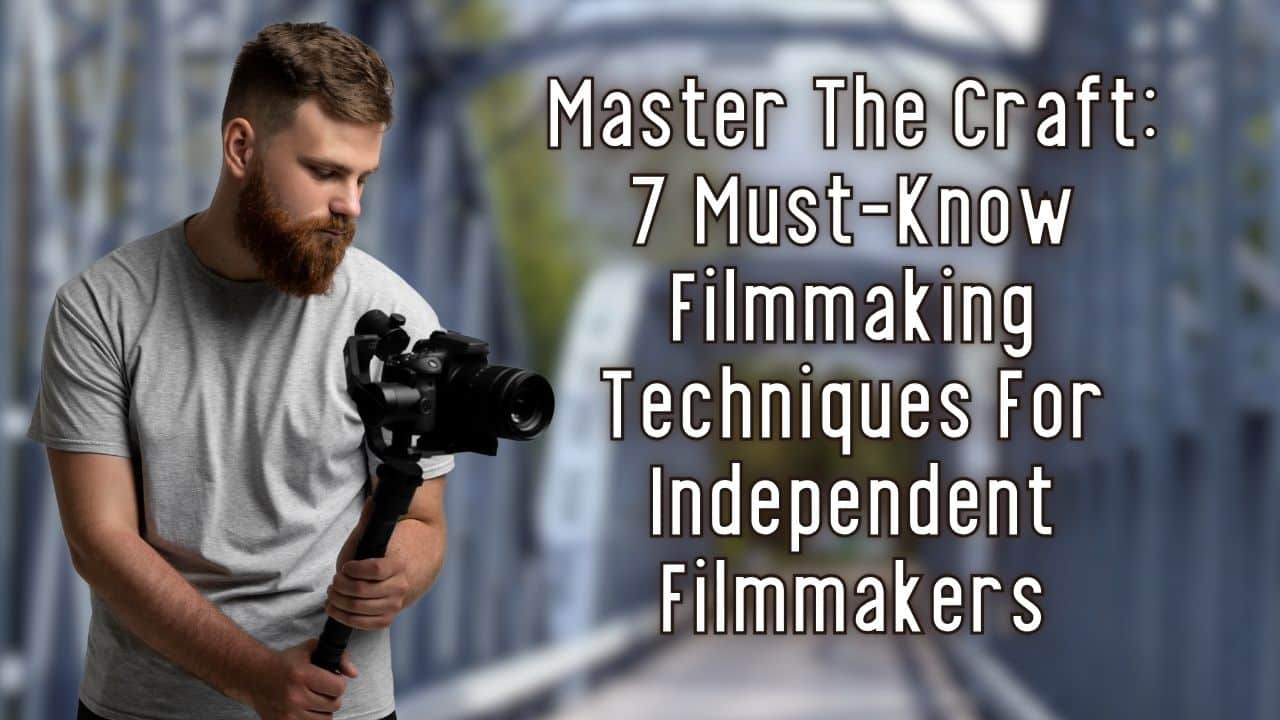As an Amazon Associate I earn from qualifying purchases.
On The Table Read Magazine, “the best creativity magazine in the UK“, we check out top tips for independent filmmakers who want to master the craft of filmmaking.
Introduction to Filmmaking Techniques
Filmmaking is an art that requires a deep understanding of various techniques to create visually stunning and compelling stories. Whether you are an aspiring independent filmmaker or have already embarked on your filmmaking journey, mastering these essential techniques is crucial to elevate the quality of your films. In this article, we will explore seven must-know filmmaking techniques that every independent filmmaker should be familiar with.
Importance of Mastering Filmmaking Techniques

Mastering filmmaking techniques is vital for independent filmmakers as it allows them to bring their creative vision to life. Through the effective use of techniques, filmmakers can enhance the storytelling process, evoke emotions in the audience, and create a memorable cinematic experience.
By understanding and applying these techniques, independent filmmakers can overcome the limitations of budgets and resources, making their films stand out in the competitive industry.
Basic Camera Techniques for Independent Filmmakers
A solid grasp of basic camera techniques is essential for independent filmmakers to capture visually appealing shots. Understanding composition, framing, and camera movement can make a significant difference in the overall quality of your film. For instance, the rule of thirds can help you create a balanced and aesthetically pleasing composition. Experimenting with different camera angles, such as low-angle or high-angle shots, can add depth and visual interest to your scenes.
Additionally, incorporating camera movements like pans, tilts, and tracking shots can bring dynamism and energy to your storytelling.
Lighting Techniques for Enhancing Your Shots
Lighting is a crucial element in filmmaking that greatly impacts the mood and atmosphere of your scenes. For independent filmmakers working with limited resources, mastering lighting techniques becomes even more important. Understanding the principles of three-point lighting – key light, fill light, and backlight – can help you create a balanced and visually appealing look.
Additionally, experimenting with natural light or using artificial lighting sources like LED panels or softboxes can add depth and dimension to your shots. Don’t be afraid to play with shadows and highlights to evoke the desired emotions in your audience.
Sound Techniques to Improve the Overall Quality of Your Film
Sound is often underestimated but plays a vital role in the overall quality of a film. As an independent filmmaker, you must invest time and effort into mastering sound techniques. Capturing clean and high-quality audio during production is crucial. Using external microphones, such as shotgun or lapel mics, can significantly improve the audio fidelity.
Additionally, learning the art of sound design and foley can enhance the immersive experience for your audience. Don’t forget the importance of music and soundtracks in setting the tone and enhancing the emotional impact of your film.
Editing Techniques for Creating a Compelling Narrative

Editing is where the magic of storytelling truly happens. Independent filmmakers must understand the art of editing to create a compelling narrative that engages the audience. Mastering techniques like shot sequencing, pacing, and continuity editing can help you craft a cohesive and seamless story.
Experiment with different editing styles, such as jump cuts or match cuts, to add visual interest and create a unique cinematic experience. Additionally, understanding the power of sound editing and color grading can further elevate the overall quality of your film.
Special Effects Techniques for Adding Visual Impact
Special effects can add visual impact and create stunning visuals in your films. While independent filmmakers may not have access to the resources of big-budget productions, there are still several techniques they can utilize to incorporate special effects. Practical effects, such as using props or practical makeup, can create impressive visuals without relying on expensive CGI.
Experimenting with camera tricks, like forced perspective or stop motion, can also add a touch of magic to your scenes. Additionally, learning basic compositing and visual effects software can help you achieve professional-looking effects on a budget.
Cinematography Tips for Capturing Stunning Visuals
Cinematography is the art of capturing stunning visuals through the lens of your camera. As an independent filmmaker, mastering cinematography tips can take your films to the next level. Understanding the role of framing, color palette, and camera movement can greatly enhance the visual appeal of your shots. Experiment with different lenses and filters to achieve the desired look and atmosphere.
Pay attention to the lighting conditions and make adjustments to create the perfect balance between exposure and shadows. Remember, cinematography is not just about technical expertise but also about storytelling through visuals.
Resources to Learn and Improve Your Filmmaking Techniques
There are numerous resources available for independent filmmakers to learn and improve their filmmaking techniques. Online platforms such as YouTube and Vimeo offer a wealth of tutorials and educational content from industry professionals. Consider enrolling in filmmaking courses or workshops to gain hands-on experience and learn from experts.
Additionally, networking with fellow filmmakers and joining film communities can provide valuable insights and opportunities for collaboration. Remember, continuous learning and practice are key to honing your filmmaking skills.
Conclusion
Mastering the craft of filmmaking requires a deep understanding of various techniques. As an independent filmmaker, investing time and effort into learning and applying these techniques can greatly elevate the quality of your films. From basic camera techniques to special effects and cinematography tips, each aspect plays a crucial role in creating visually stunning and compelling stories. Embrace the challenges and limitations of independent filmmaking, and let your creativity and passion shine through. With dedication and practice, you can master these must-know filmmaking techniques and make a mark in the world of cinema.
We strive to keep The Table Read free for both our readers and our contributors. If you have enjoyed our work, please consider donating to help keep The Table Read going!
Amazon and the Amazon logo are trademarks of Amazon.com, Inc, or its affiliates.


